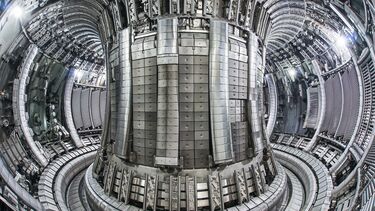Fusion thermal hydraulics

Fusion reactor technology has attracted growing interests internationally, which once successfully developed will provide effectively unlimited clean energy. Unlike nuclear fission, fusion energy will not produce long-lasting radioactive wastes.
There are however major technological obstacles to be overcome before fusion becomes reality. Fusion reactors are featured with extreme heat flux (up to 20 MW/m2) and complex multi-physics including magnetohydrodynamics (MHD), which present huge challenges to the design and build of such systems.
At Sheffield, our interest is to leverage our extensive knowledge and skills in nuclear fission technology (i) to develop modelling and simulation tools for the prediction of the component as well as system behaviours of the cooling systems (including the first-wall, the breeding blanket and the divertor), and (ii) to advance the understanding of the complex physics in the reactor systems, especially including magnetohydrodynamic (MHD).
We currently pursue a number of research projects in collaboration with UKAEA thermal hydraulics and advanced engineering simulations teams, and STFC Daresbury Laboratory.
- Multiscale Simulation for Fusion Components. The project is aimed at developing multi-scale system modelling methodologies and tools for the breeding blanket and associated plant system to enable system-level modelling coupled with embedded and/or off-line high-fidelity CFD simulations. This is part of the UKAEA/University of Sheffield Partnership Agreement [UKAEA news, UoS news].
- Fundamental study of turbulence in fusion technology using direct numerical simulation (DNS). This PhD project expands the DNS package CHAPSim to include a MHD module, which is used to study the fundamental behaviours of turbulent flow under various conditions including non-uniform wall conditions. The project is in collaboration with UKAEA and STFC Daresbury Lab.
- High-fidelity simulation for liquid-metal magnetohydrodynamic effects in fusion applications. This study is aimed at better understanding and prediction of the MHD-influenced turbulent cooling phenomena in geometries/conditions directly relevant to the fusion bleeding blanket. In particular, the project will target at specific needs associated with the UKAEA facilities such as CHIMERA, LLiMFA and SmallLab. This project is co-funded by the Fusion Power CDT and a UKAEA studentship.
